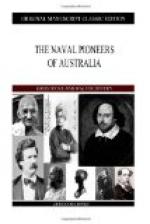This ship was on her way out with female prisoners and a few of the better sort of male convicts. The soldiers joined with the seamen and seized the ship, turning those who would not take side with them adrift in the boats. Among these loyal people were some of the male convicts. The boats made their way to Rio Janeiro, whence the people ultimately reached England. Among the “respectable” convicts was one Major Semple, a notorious swindler of the time, who on this occasion behaved well, risking his life for the protection of the ship’s officers—from the soldiers who had been put on board to support law and order! (He afterwards settled in the Brazils, and received his pardon from England.) The ship was carried by the mutineers into Monte Video and there given up to the Spaniards, who later, finding the true character of the people on board of her, hanged the ringleader and delivered up others of her crew to the English naval authorities. The female convicts had been carried off by the soldiers, and when the Rev. William Gregory arrived at Monte [Sidenote: 1798-1807] Video (a prisoner of war taken in the missionary ship Duff on her second voyage), he found these women there. They had by their conduct given the Spaniards a curious idea of the morality of Englishwomen.[F] Among the rebellious soldiers were many foreigners, and when the mutineers seized the vessel they announced that they had taken her in the name of the French Republic. They addressed one another as “Citizen” this and “Citizen” that, and behaved generally in the approved manner of those “reformers” of the period who had been inspired by the French revolutionists.
[Footnote F: The Duff was captured by the Bonaparte, privateer. Among her passengers were several ladies—wives of the missionaries—and at first the citizens of Monte Video classed them with the Lady Shore’s female passengers.]
In the chapters on King and Bligh the mutinies of this remarkable regiment form almost the principal episodes, so we may conclude this chapter with what short regimental history the corps possessed.
As the colony grew in population the corps was increased in strength, until, in 1807, it reached a total of 11 companies, numbering 886 non-commissioned officers and men. In 1808 came the Bligh episode, yet to be described. The home Government recalled the corps, and a battalion of the 73rd, 700 strong, was sent out to relieve it. Authority was, however, given to make up the 73rd to the strength of 1000 by taking volunteers from the corps. This was done, and a veteran company was also formed, and the strength of the 73rd then reached a total of 1234 soldiers, of whom something like 500 men originally belonged to the New South Wales Corps. The remainder of the old corps went home, and was placed on the army list as the 102nd Regiment. Before this its official title was the New South Wales Corps, but the newspapers of the day often varied this by calling it the Botany Bay Rangers and similar appropriate names.




